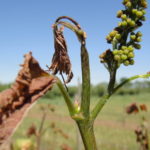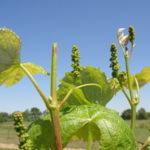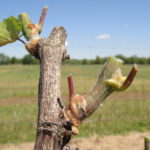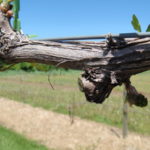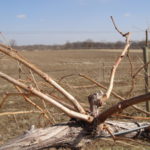Growers across the state experienced some damage from frost and freeze events on May 7, 8, and 9. Damage is scattered across the state and ranges from minor to severe. We did not have damage in the Lafayette area, but areas of northern and northeastern Indiana were hit. Surprisingly some damage occurred in south central and east central regions as well. It was an unusual weather situation where dew point temperatures were very low. That means the the air was very dry, which allowed the temperatures to drop more than usual. Temperatures ranged from 31˚ to 35˚F across the state at the Purdue Ag Centers. But as in all radiative events, site elevation was critical. Lower elevations saw the coldest temperatures and the most damage. Some areas had light winds that helped reduce the temperature inversions that normally occur.
There is little that can be done at this point. If the entire primary shoot was killed, secondary buds will break and grow. Depending on variety, there can be a partial or nearly full crop from secondary shoots. However, in this event, many shoots are only partially killed. Usually several of the youngest leaves and the shoot tip was damaged. Flower clusters may or may not have been killed. In these situations, lateral shoots will usually grow from the leaf axils at the base of the primary shoot, rather than the secondary shoot growing. This can result in low yields and an undesirable situation next year where most canes are branched and small in diameter, poor quality for fruiting spurs.
We had a very similar frost event in 2010 so I did a study on six different varieties to evaluate management strategies. I looked at different strategies for dealing with the partially killed primary shoots, from tipping the primary shoot, removing the shoot entirely, or removing the spur entirely. On varieties where flower clusters were not damaged, the highest yields occurred where we either tipped the damaged shoots or did nothing at all. But when the flower clusters were damaged and there was little potential for a crop, we found that entirely removing the spurs resulted in the best situation the following year. That treatment lead to an abundance of healthy canes to select from. Basically it allowed us to “renew” the cordon without removing the cordon. My conclusion was that growers should consider complete removal of frost damaged shoots, and spurs on cordons that need renovation, if practical, to insure availability of high quality fruiting spurs the following season. This frost event gives growers the opportunity to clean up old cordons and encourage new spur development. What’s the saying? When life gives you lemons, make lemonade!
- Marquette with dead shoot tip
- Shoots tipped
- Shoots cut back to basal nodes
- Spurs removed
- New spur development when spurs removed
- Poor quality canes when shoots were tipped
